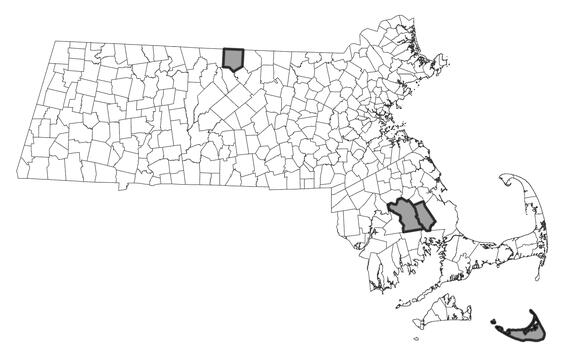- Scientific name: Lycopus rubellus
- Species of Greatest Conservation Need (MA State Wildlife Action Plan)
- Endangered (MA Endangered Species Act)
Description
The perennial herb taperleaf water-horehound is a non-aromatic member of the mint family reaching a height of 0.5 m (18 in) but more often only 0.3 m (1 ft) high in Massachusetts. The slender, erect, sparsely branching stems bear simple, opposite leaves arranged in vertical ranks of pairs which are relatively widely spaced on the stem. The stem bases send out many slender and long, freely branching runners that form tubers at their ends. The broadly lance-shaped to oval leaves are 4-12 cm (1.6-4.7 in) long and 0.4-1.6 in wide and the basal part of each leaf is distinctly straight or slightly concave as it tapers to the petiole. The leaf margins are coarsely shallow-toothed above the elongated bases and smooth below.
The small, white, faintly purple-spotted flowers are densely clustered at the junction of the stem and leaves and form doughnut-shaped whorls around the stem. The five-lobed, tubular corolla is composed of petals which flare abruptly outwards and extend 2-3 mm (0.08-0.12 in) beyond (twice as long as) the surrounding calyx tube. The lobes of the calyx tube are narrowly triangular and long pointed. The mature fruits of taperleaf water-horehound consist of a set of four nutlets per flower, each roughly triangular-shaped with narrow bases and broad tops. The shape and surface of the nutlets, apparent with a hand lens, are useful characters for separating species of Lycopus. In L. rubellus, the top of the nutlet is jagged with tuberculate (bumpy), thickened edges called crests. Flowering and fruiting occurs from mid-July through mid-September.
All five native species of Lycopus are much alike in habit and general leaf shape. Virginian water-horehound (Lycopus virginicus) most closely resembles taperleaf water-horehound; the leaves taper in the same manner. The calyx teeth differ, however, being ovate or acute and not long-pointed, and the four-lobed corolla is non-flaring. It usually inhabits floodplain forests, or occasionally red maple swamps. American water-horehound (Lycopus americanus), also known as cut-leaved water-horehound, normally has deeply lobed middle and lower leaves, but when these are merely toothed, it can be distinguished by very long, sharp-tipped or needle-like calyx lobes, a shorter and four-lobed corolla (about equal to the calyx), and smooth nutlets with rounded tops. It inhabits a variety of wetland types. Common water-horehound (Lycopus uniflorus) has narrower, shorter leaves with only a few small teeth. Its calyx lobes are acute, not long-pointed. The underground base of the stem is enlarged to form a short thick tuber or rootstalk. It inhabits pond shores as well as various wetlands. Clasping water-horehound (Lycopus amplectens) is our only species with sessile leaves (no stalks), and it is restricted to the shores of coastal plain ponds.
Life cycle and behavior
This is a perennial species.

Population status
There are currently six known populations of taperleaf water-horehound, resulting in its designation as an endangered species in Massachusetts. The status of taperleaf water-horehound is only now being understood, due to past misidentification and confusion with other species. The Massachusetts Natural Heritage & Endangered Species Program has 13 records from 5 counties: Barnstable, Bristol, Nantucket, Norfolk, and Plymouth. Seven of these records have been observed within the last 25 years.
Distribution and abundance
Taperleaf water-horehound is distributed from eastern Massachusetts southward to Florida and eastern Texas on the coastal plain, and northwards through the Mississippi River basin to southern Michigan. It is only sporadically found in the area between the Mississippi and the Atlantic Coast.

Distribution in Massachusetts
1999-2024
Based on records in the Natural Heritage Database
Habitat
Taperleaf water-horehound is most abundant on damp soils of the Atlantic coastal plain and Mississippi River basin, where it is found along streams in maple swamps, marshy shores of ponds and lakes, seepage areas, and floodplain forests. In Massachusetts, its habitat is only now beginning to be known with certainty. Current populations are found along small streams in red maple swamps, in association with sweet pepperbush, smooth arrowwood, and netted chain-fern. Historically, it also was known from borders of ponds in Fall River and Westport.
Healthy habitats are vital for supporting native wildlife and plants. Explore habitats and learn about conservation and restoration in Massachusetts.
Threats
Conservation
References
Contact
| Date published: | May 6, 2025 |
|---|